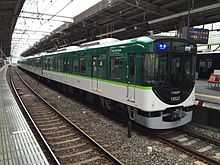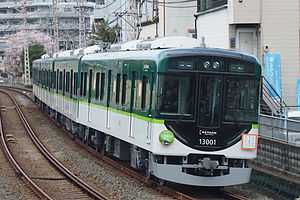Keihan 13000 series
| Keihan 13000 series | |
|---|---|
|
Set 13001 on the Uji Line, April 2012 | |
| In service | 14 April 2012 |
| Manufacturer | Kawasaki Heavy Industries |
| Built at | Kobe |
| Family name | City commuter |
| Replaced | Keihan 2600 series |
| Constructed | 2013– |
| Number built | 38 vehicles (8 sets) |
| Number in service | 38 vehicles (8 sets) |
| Formation | 4/7 cars per trainset |
| Fleet numbers | 13001– |
| Capacity | 540 |
| Operator | Keihan Electric Railway |
| Line(s) served | Keihan Uji Line, Keihan Katano Line |
| Specifications | |
| Car body construction | Aluminium alloy |
| Car length |
18,900 mm (62 ft 0 in) (end cars) 18,700 mm (61 ft 4 in) (intermediate cars) |
| Width | 2,792 mm (9 ft 1.9 in) |
| Doors | 3 pairs per side |
| Maximum speed | 110 km/h (70 mph) |
| Traction system | variable-frequency |
| Acceleration | 2.8 km/h/s |
| Deceleration | 4.0 km/h/s (service), 4.3 km/h/s (emergency) |
| Electric system(s) | 1,500 V DC |
| Current collection method | Overhead wire |
| Bogies | KW-77D (motored), FS577 (trailer) |
| Safety system(s) | Keihan ATS |
| Track gauge | 1,435 mm (4 ft 8 1⁄2 in) |
The Keihan 13000 series (京阪13000系 Keihan 13000-kei) is an electric multiple unit (EMU) commuter train type operated by the Keihan Electric Railway on the Keihan Uji Line and other lines in Kyoto, Japan, since April 2012. A total of five 4-car sets are on order, intended to replace 20 life-expired 2600 series vehicles.[1][2]
Design
The overall design concept draws on the design of the 3000 series EMU trains introduced from 2008.[1]
The new trains include energy-saving and environmentally friendly features. The 13000 series trains will use 35% less power than the 2600 series they are intended to replace, and produce less environmental noise in service.[1] The cars feature aluminium alloy bodies with a semi-double skin construction, and incorporate increased crash resistance.[1]
The end cars are each equipped with one PT-4805-A scissors-type pantograph recycled from withdrawn rolling stock.[3]
Interior
Internally, LCD passenger information screens are provided above doorways.[1]
Longitudinal bench seating use contoured "bucket seats" with a width of 470 mm (19 in) per passenger.[1]
Luggage racks are lowered by 20 mm to a height of 1,750 mm for accessibility, with the racks above priority seating lowered 50 mm to a height of 1,720 mm.[1]
The interior flooring design is intended to evoke an image of Kyoto's traditional stone-paved streets.[4]
The 2nd-batch sets, 13006 onward, use LED lighting.[5]
-
Interior of a 13020 series set, June 2014
-
7-person bench seat
-
Sliding doors and LCD passenger information screen
Formations

The trains are formed as follows, with the Mc1/Mc3 cars at the Kyoto/Uji end.[3]
Odd-numbered sets
| Designation | Mc1 | T0 | T1 | Mc4 |
|---|---|---|---|---|
| Numbering | 13000 | 13500 | 13650 | 13050 |
| Weight (t) | 36.0 | 28.5 | 26.0 | 36.5 |
| Capacity (total/seated) |
128/43 | 137/49 | 137/49 | 128/43 |
Even-numbered sets
| Designation | Mc3 | T0 | T1 | Mc2 |
|---|---|---|---|---|
| Numbering | 13000 | 13500 | 13650 | 13050 |
| Weight (t) | 36.5 | 28.5 | 26.0 | 36.0 |
| Capacity (total/seated) |
128/43 | 137/49 | 137/49 | 128/43 |
- "Mc" cars are motored driving cars (with driving cabs).
- "T" cars are unpowered trailer cars.
- The Mc cars each have one PT-4805-A scissors-type pantograph.[3]
- The Kyoto/Uji end Mc3 cars of even-numbered sets are fitted with gangway connections, enabling coupling to the Nakanoshima end Mc4 cars of odd-numbered sets.[3][6]
History
The first set, 13001, was delivered from the Kawasaki Heavy Industries factory in Kobe to Keihan's Neyagawa Depot in March 2012.[7] It entered service on 14 April 2012.[3] The second set, 13002, entered revenue service on 30 May 2012.[6]
From 9 June 2012, 13000 series sets were also introduced on the Keihan Katano Line.[8]
The first second-batch set, 13006, entered service on 7 April 2014, followed by two 7-car sets, 13021 and 13022.[5]
Fleet history
The build history for the fleet is as shown below.[9]
| Set No. | Delivered | Notes |
|---|---|---|
| 13001 | FY2011 | 4-car set |
| 13002 | FY2012 | 4-car sets |
| 13003 | ||
| 13004 | ||
| 13005 | ||
| 13006 | FY2013 | 4-car set |
| 13021 | FY2014 | 7-car sets |
| 13022 |
References
- ↑ 1.0 1.1 1.2 1.3 1.4 1.5 1.6 新型車両13000系20両を新造します。 [20 New 13000 Series Cars to be Built] (PDF). News Release (in Japanese). Japan: Keihan Electric Railway. 12 December 2011. Retrieved 12 December 2011.
- ↑ 宇治・伏見観光キャンペーン [Uji & Fushimi Tourist Promotion] (PDF). News Release (in Japanese). Japan: Keihan Electric Railway. 23 March 2012. Retrieved 27 March 2012.
- ↑ 3.0 3.1 3.2 3.3 3.4 京阪電気鉄道13000系 [Keihan Electric Railway 13000 series]. Japan Railfan Magazine (in Japanese) (Japan: Kōyūsha Co., Ltd.) 52 (614): p.78–82. June 2012.
- ↑ Kameda, Sanae (12 December 2011). 京阪電鉄:来春から「13000系」20両順次導入 [Keihan Electric Railway to introduce 20 13000 series cars from next spring]. Mainichi jp (in Japanese). Japan: The Mainichi Newspapers. Retrieved 13 December 2011.
- ↑ 5.0 5.1 京阪電気鉄道13000系に2次車が登場 [Keihan 13000 series 2nd-batch set appears]. Japan Railfan Magazine (in Japanese) (Japan: Koyusha Co., Ltd.) 54 (639): p.99. July 2014.
- ↑ 6.0 6.1 京阪13000系第2編成が営業運転を開始 [Second Keihan 13000 series set enters service]. Japan Railfan Magazine Online (in Japanese). Japan: Koyusha Co., Ltd. 1 June 2012. Retrieved 1 June 2012.
- ↑ 京阪13000系第1編成の搬入が終了 [First Keihan 13000 series set delivered]. Japan Railfan Magazine Online (in Japanese). Japan: Koyusha Co., Ltd. 14 March 2012. Retrieved 16 March 2012.
- ↑ 京阪13000系,交野線で営業運転開始 [Keihan 13000 series enter service on Katano Line]. Japan Railfan Magazine Online (in Japanese). Japan: Koyusha Co., Ltd. 10 June 2012. Retrieved 10 June 2012.
- ↑ Kusui, Toshihiko (January 2015). 大手私鉄10年間の車両のうごき [Major Private Railway Rolling Stock Changes over the past 10 years]. Japan Railfan Magazine (in Japanese) (Japan: Koyusha Co., Ltd.) 55 (645): p.44-45.
External links
| Wikimedia Commons has media related to Keihan 13000 series. |
- Official website (Japanese)
| ||||||||||||||||



